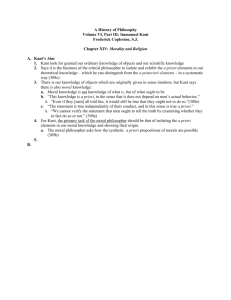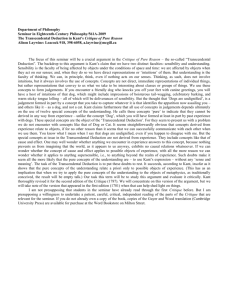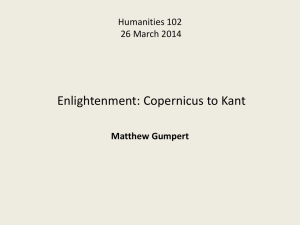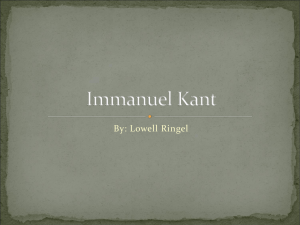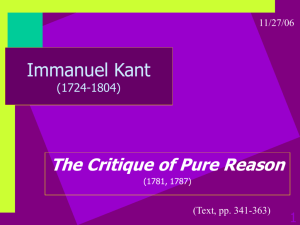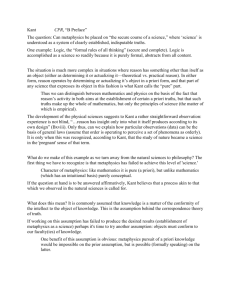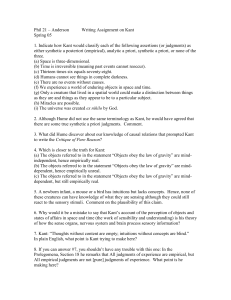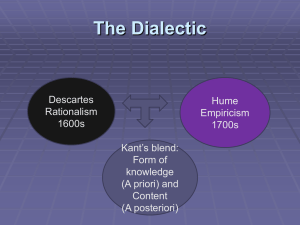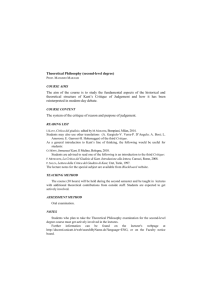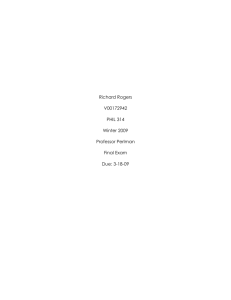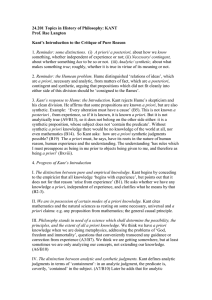Reading 17
advertisement
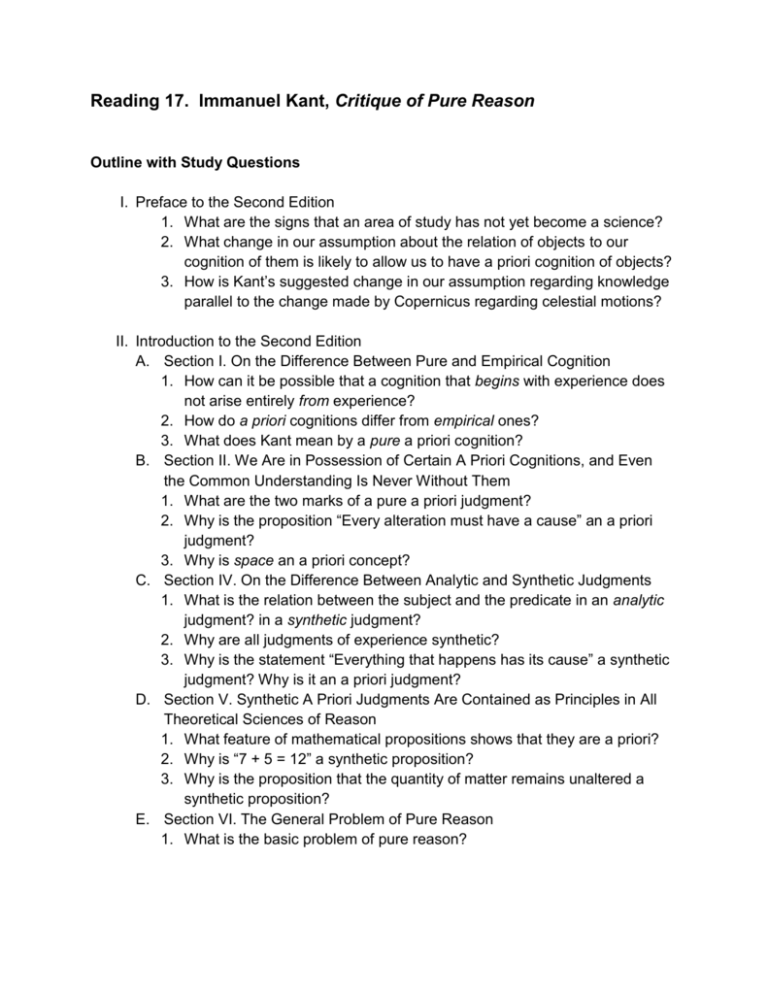
Reading 17. Immanuel Kant, Critique of Pure Reason Outline with Study Questions I. Preface to the Second Edition 1. What are the signs that an area of study has not yet become a science? 2. What change in our assumption about the relation of objects to our cognition of them is likely to allow us to have a priori cognition of objects? 3. How is Kant’s suggested change in our assumption regarding knowledge parallel to the change made by Copernicus regarding celestial motions? II. Introduction to the Second Edition A. Section I. On the Difference Between Pure and Empirical Cognition 1. How can it be possible that a cognition that begins with experience does not arise entirely from experience? 2. How do a priori cognitions differ from empirical ones? 3. What does Kant mean by a pure a priori cognition? B. Section II. We Are in Possession of Certain A Priori Cognitions, and Even the Common Understanding Is Never Without Them 1. What are the two marks of a pure a priori judgment? 2. Why is the proposition “Every alteration must have a cause” an a priori judgment? 3. Why is space an a priori concept? C. Section IV. On the Difference Between Analytic and Synthetic Judgments 1. What is the relation between the subject and the predicate in an analytic judgment? in a synthetic judgment? 2. Why are all judgments of experience synthetic? 3. Why is the statement “Everything that happens has its cause” a synthetic judgment? Why is it an a priori judgment? D. Section V. Synthetic A Priori Judgments Are Contained as Principles in All Theoretical Sciences of Reason 1. What feature of mathematical propositions shows that they are a priori? 2. Why is “7 + 5 = 12” a synthetic proposition? 3. Why is the proposition that the quantity of matter remains unaltered a synthetic proposition? E. Section VI. The General Problem of Pure Reason 1. What is the basic problem of pure reason? 2. What three areas of inquiry contain a theoretical a priori cognition of objects? 3. Why is the scope of the science of pure reason not extensive? III. The Transcendental Doctrine of Elements. First Part: The Transcendental Aesthetic A. Introduction 1. What does Kant mean by “sensibility”? Why is all thought related to it? 2. What is the transcendental aesthetic? How does it differ from the transcendental logic? B. First Section: On Space 1. Why is the representation of space a priori and not empirical? C. Second Section: On Time 1. Why is the representation of time a priori and not empirical? IV. The Analytic of Concepts. First Chapter: On the Clue to the Discovery of All Pure Concepts of Understanding A. Second Section: On the Logical Function of Understanding in Judgments 1. What are the four headings under which all judgments fall? B Third Section: On the Pure Concepts of the Understanding, or Categories 1. Why is the number of categories the same as the number of possible judgments? Questions for Reflection and Discussion 1. Do objects really exist in space and time, or is that simply how we experience them? 2. Can we be certain that every alteration has a cause? If so, is this because every alteration really does have a cause or because our minds experience reality through the a priori category of cause and effect? 3. Does the fact that we experience objects though our mental framework mean that we can know only how things appear to us and not know objects as they are in themselves? 4. If we know only how things appear to us, can we be certain that things are anything more than appearances? 5. Can the mind, by reflecting on itself, know its own structure? For Further Reading Ewing, A. C. A Short Commentary on Kant’s Critique of Pure Reason. London, England: Methuen, 1938. 278 pp. See Chapter 2, “The Transcendental Aesthetic” (pp. 28–65), and Chapter 3, “The Transcendental Deduction of Categories” (pp. 66–131). Gardner, Sebastian. Routledge Philosophy Guidebook to Kant and the Critique of Pure Reason. New York: Routledge, 1999. 377 pp. See Chapter 3, “How Are Synthetic A Priori Judgements Possible? (The Introduction [by Kant]),” pp. 51–63. Scruton, Roger. Kant. New York: Oxford University Press, 1982. 99 pp. See Chapter 3, “The Transcendental Deduction” (pp. 22–40), and Chapter 4, “The Logic of Illusion” (pp. 41–57). Smith, Norman Kemp. A Commentary to Kant’s Critique of Pure Reason. 2d ed. London, England: Macmillan, 1923. 651 pp. This work contains commentaries on Kant’s “Preface to the Second Edition” (pp. 17–25) and Kant’s “Introduction [to the Second Edition]” (pp. 26–78). Wilkerson, T. E. Kant’s Critique of Pure Reason: A Commentary for Students. 2d ed. Bristol, England: Thoemmes Press, 1998. 224 pp. Chapter 1, “Kant’s Enterprise” (pp. 3–18), gives an overview of Kant’s project in Critique of Pure Reason.
